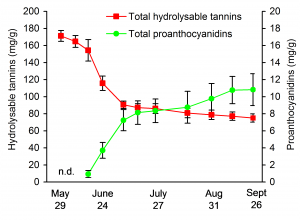It is surprising if proanthocyanidins are found to accumulate in spring foliage, especially in species that dominantly produce hydrolysable tannins – late summer and autumn are more natural peaks for proanthocyanidins
Proanthocyanidins accumulate in autumn foliage – almost invariably
There are not too many details to be shown about the seasonal variation of proanthocyanidins, since most of the studies have focused on analyzing only total proanthocyanidins. Nevertheless, it seems that at least in tree foliage the patterns of seasonal variation are highly repeatable and similar: young foliage contains low or negligible levels of proanthocyanidins, while they tend to accumulate in mature leaves and stay high even until the autumn. Given that the species produces proanthocyanidins in the first place, of course.
Hydrolysable tannins and proanthocyanidins do not peak at the same time

Figure 1. Seasonal variation of hydrolysable tannins and proanthocyanidins show opposite patterns in the foliage of Quercus robur as shown by Salminen et al. (2004).
In a big picture the seasonal variation of both hydrolysable tannins and proanthocyanidins can be simplified as in the Fig. 1. The former go down with the season and the latter go up, i.e. their levels are almost inversely correlated. Such a pattern is logical also from the biosynthesis point of view, since the production of high levels of hydrolysable tannins in the spring foliage consumes a lot of biosynthetic energy from the shikimate pathway. Since proanthocyanidins require both shikimate and acetate-malonate pathways, they cannot be easily accumulated at the same time with hydrolysable tannins. This is especially true if the combination of these pathways is used at the same time for the production of flavonoid aglycones and/or flavonoid glycosides.
There is a maximum level of tannins that can be produced in the foliage
All the above depends of course on the levels of tannins produced. For instance in birch leaves proanthocyanidins may reach in the autumn levels of 200 mg/g and in oaks hydrolysable tannins may reach in the spring similar levels of 200 mg/g. These levels would be impossible to produce in the same species and especially at the same time. In fact, one cannot think – not even in theory – that some foliage could contain 400 mg/g levels of tannins at any given time. The reason is quite clear. Any given 100 mg DW of foliage contains approximately 50% of the insoluble extraction residue, meaning that a maximum of 50 mg of metabolites will be transferred into the plant extract. Typically free carbohydrates make the most of this extract and together with lipophilic substances such as waxes, chlorophylls, carotenoids and other terpenes, these make up to 50% of the mass of the extract. What is left is 25 mg and this means that water-soluble metabolites such as polar polyphenols/tannins can be found in a maximum of 250 mg/g DW concentration in the foliage. If much larger contents are found, then results can or should be questioned. The only option how such results could be explained is that the analysed tissue was very soft (like petals for instance) and very low in its extraction residue (fibers). For these reasons the peak 200 mg/g levels of proanthocyanidins in birch co-occur with the lowest levels of HTs, and the 200 mg/g levels of HTs in oak co-occur with the lowest levels of PAs.
“Okay, so you have 400 mg/g of tannins in your plant – are you sure?”
